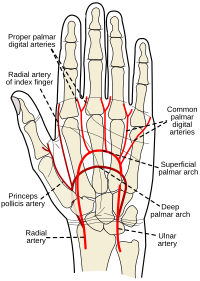
Photo from wikipedia
OBJECTIVE Our study aimed to find the maximum rate of increase in distal radial artery size. PATIENTS AND METHODS Diameter measurements were obtained on transverse and sagittal sections of the… Click to show full abstract
OBJECTIVE Our study aimed to find the maximum rate of increase in distal radial artery size. PATIENTS AND METHODS Diameter measurements were obtained on transverse and sagittal sections of the artery with a high-frequency linear transducer (Philips ClearVue L12-4 Mhz). In the baseline evaluation, radial artery and distal radial artery diameters were measured. The patients were divided into two groups: patients with flow-mediated dilatation in Group I and patients with 30 mg Topical Nitroglycerin in Group II. Group II patients were divided into two groups 30 minutes after topical nitroglycerin; patients with flow-mediated dilatation (FDM) in Group IIa, patients with wrist warming plus FMD in Group IIb. RESULTS A significant increase was found between baseline and second measurements in the radial artery (2.64±0.46 and 2.36±0.39 mm; p=0.02 in Group I, 2.78±0.38 and 2.39±0.25 mm; p=0.01 in Group II) and distal radial artery (2.29±0.49 and 1.93±0.37 mm; p=0.02 in Group I, 2.32±0.28 and 1.96±0.44 mm; p=0.04 in Group II) diameters. Radial (3.02±0.55 and 2.78±0.38 mm; p<0.01) and distal radial artery (2.55±0.32 and 2.32±0.28 mm; p=0.01) diameters increased compared to the second measurements in Group IIa. Radial (3.25±0.35 and 2.78±0.38 mm; p<0.01) and distal radial artery (2.88±0.12 and 2.32±0.28 mm; p<0.01) diameters increased compared to the second measurements in Group IIb. The results of the final evaluations of the two groups were compared, radial (3.02±0.55 and 3.25±0.35 mm; p=0.04) and distal radial artery (2.55±0.32 and 2.88±0.12 mm; p=0.03) diameters were found to be significantly higher in Group IIb than Group IIa. When comparing baseline and final evaluations, the radial artery diameter was increased by 37%, and the distal radial artery diameter was increased by 49% in Group IIb. CONCLUSIONS We increased the radial artery diameter higher proportion than defined in the literature.
Journal Title: European review for medical and pharmacological sciences
Year Published: 2023
Link to full text (if available)
Share on Social Media: Sign Up to like & get
recommendations!